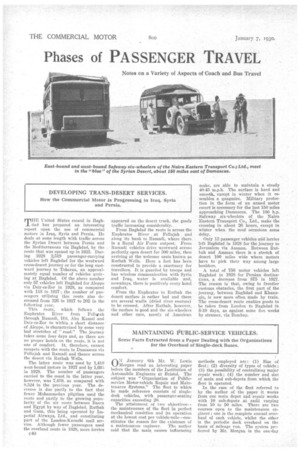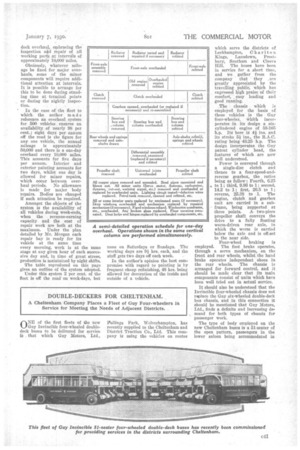MAINTAINING 1 3 UBLIC-SERVICE VEHICLES.
Page 62

Page 63

If you've noticed an error in this article please click here to report it so we can fix it.
Some Facts Extracted from a Paper Dealing with the Organizations for the Overhaul of Single-deck Buses.
ONJanuary 6th Mr. NV. Lewis Morgan read an interesting paper before the members of the Institution of Automobile Engineers at Bristol. The subject was "Organization of Publicservice Motor-vehicle Repair and Maintenaece Systems." The fleet to which he made reference consists of singledeck vehicles, with passenger-seating capacities exceeding 20.
The attainment of two objectives-the maintenance of the fleet in perfect mechanical condition and its operation at the lowest cost per vehicle-mile--constitutes the reason for the existence of
a maintenance engineer. The author said that the main causes influencing
methods employed are : (1) Size of fleet ; (2) diversity of types of vehicle ; (3) the possibility of centralizing major repair work ; (4) the number and size of main and sub-depots from which the fleet is operated.
In the case of the fleet referred to by the author of the paper it works from one main depot and repair works with 10 sub-depots at radii varying from 10 to 50 miles. There are two courses open to the maintenance engineer ; one is the complete annual overhaul of each vehicle, whilst the other is the periodic .dock overhaul on the basis of mileage run. The system preferred by Mr. Morgan is the one-day.
dock overhaul, embracing the inspection and repair of all working parts .at intervals of approximately 10,000 miles.
Obviously, whatever mileage be fixed for major overhauls, some of the minor components will require additional attention at intervals. It is possible to arrange for this to be done during standing time at terminal points or during the nightly inspection.
In the case of the fleet to which the author made reference an overhaul system for 500 vehicles ensures an availability of nearly 98 per cent.; eight days per annum off the road is the figure for any, one vehicle, the annual mileage is approximately 50,000 and there is a one-day overhaul every 10,000 miles. This accounts for five days per annum. Interior and exterior painting accounts for two days, whilst one day is allowed for minor repairs, which occur between overhaul periods. No allowance is made for major body repairs. Bodies are changed if such attention be required.
Amongst the objects of the system is the availability of all vehicles during week-ends, when the revenue-earning capacity and the cost of repair work are both at the maximum. Under the plan detailed by Mr. Morgan each repair bay is ready for its vehicle at the same time every morning, work is at the Same stage at any given hour of each successive day and, in time of great stress, production is maintained by night shifts.
The table reproduced on this page gives an outline of the system adopted.
Under this system 2 per cent. of the fleet is off the road on week-days, but none on Safurdays or Sundays. The working days are 9-i hrs. each, and the staff gets two days off each week.
In the author's opinion the best compromise with regard to painting is by frequent cheap refinishing, 48 hrs. being allowed for decoration of the inside and outside of a vehicle. which serve the districts of Leckhampton, Charlton Kings, Lansdown, Prestbury, Southam and Cleave Hill. The buses have been in service for a short time, and we gather from the company that they ,nre greatly appreciated by the travelling public, which has expressed high praise 'of their comfort, easy loading and good running. '
The chassis which is employed for the basis of these vehicles is the Guy four-wheeler, *Ilia inept..Porates in its design a sixeylindered engine of 58-10'4 11.n. Its bore is 4+ ins, and its stroke 5i ins., the R.A.C. rating being 4:3.25 h.p. The design incorporates the Guy patent cylinder head, the features of which are now well understood.
Power is conveyed through a single-disc clutch and thence to a four-speed-andreverse gearbox, the ratios being as follow: Fourth, 6.25 to 1; third, 9.86 to 1; second, 14.2 to 1; first, 26.5 to 1; reverse, 25.18 to 1. The engine, clutch and gearbox unit are carried in a sub, frame, being supported at three points. A two-piece propeller shaft conveys the drive to a fully floating worm-driven rear axle, in which the worm is carried below the axle and is oft-set to the near side.
Four-wheel braking is employed. The foot brake operates, through a servo mechanism, on the front and rear wheels, whilst the hand brake operates independent shoes in the rear wheels. The chassis is arranged for forward control, and it should be made clear that its main components consist of units which have been well tried out in actual service.
It should also be understood that the Invincible four-wheeled chassis does not replace the Guy six-wheeled double-deck bus chassis, and in this connection it should be mentioned that Guy Motors, Ltd., finds a definite and increasing demand for both types of chassis for passenger work.
The type of body employed on the new Cheltenham buses is a 51-seater of the open pattern, passengers in the lower saloon being accommodated in












































































































